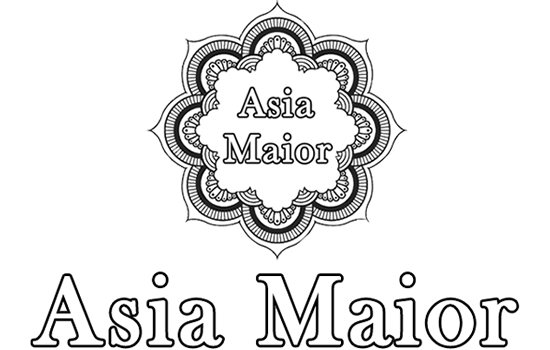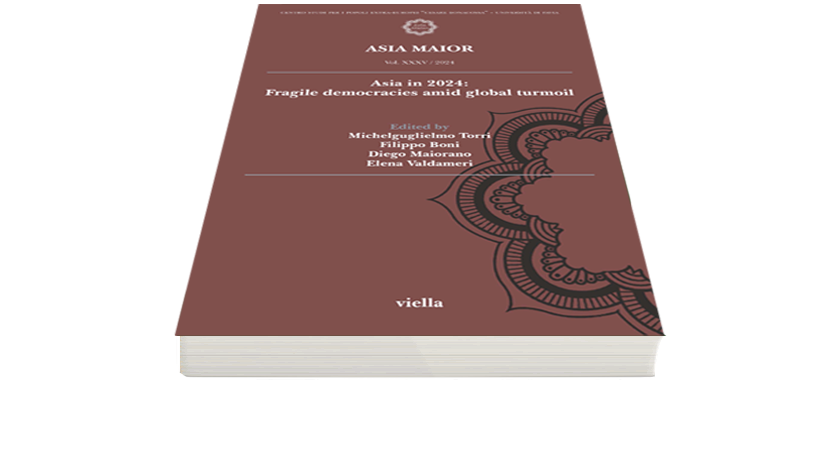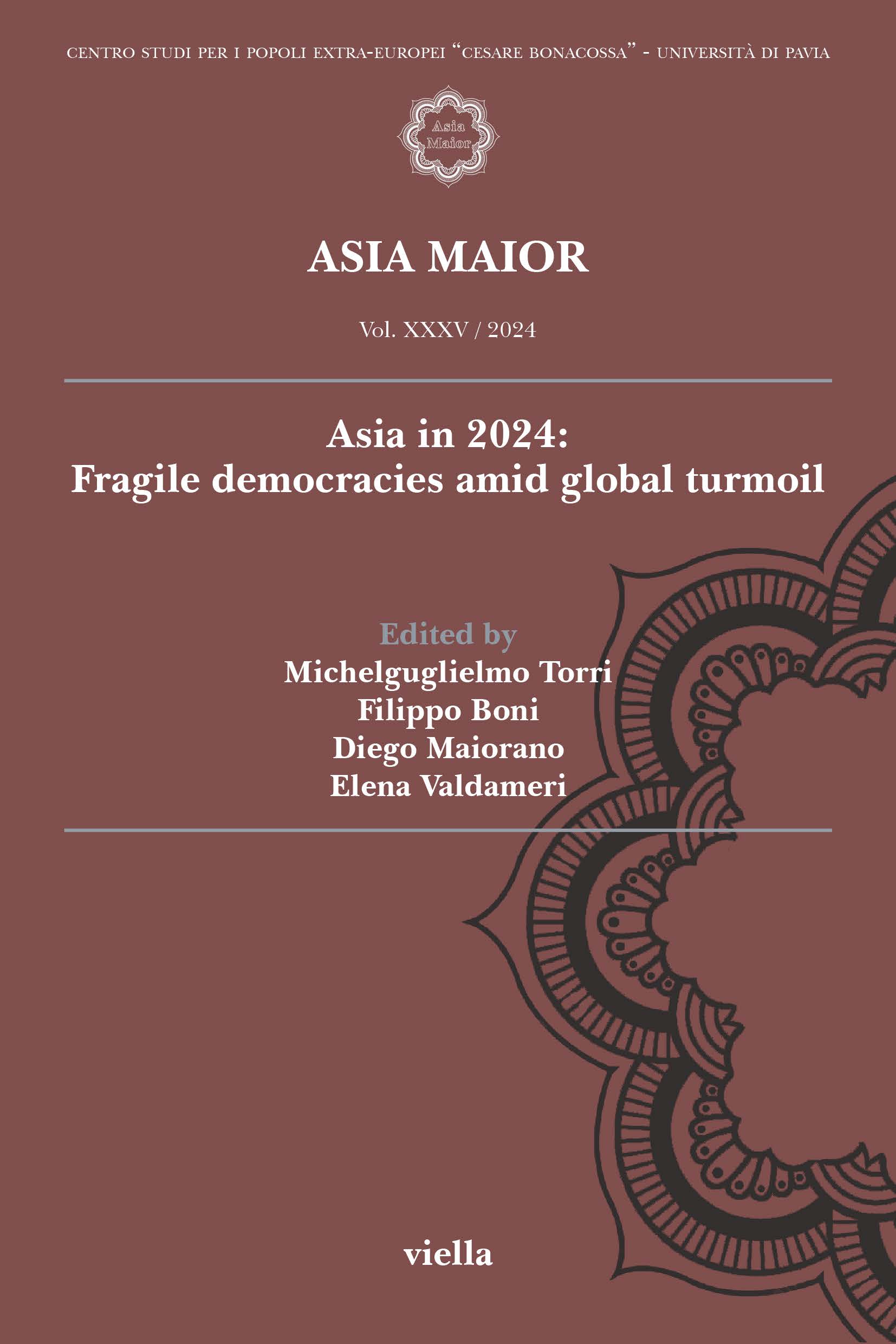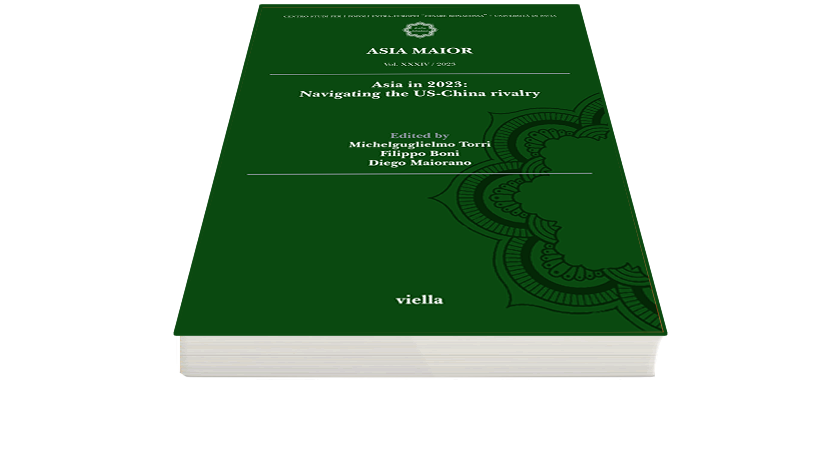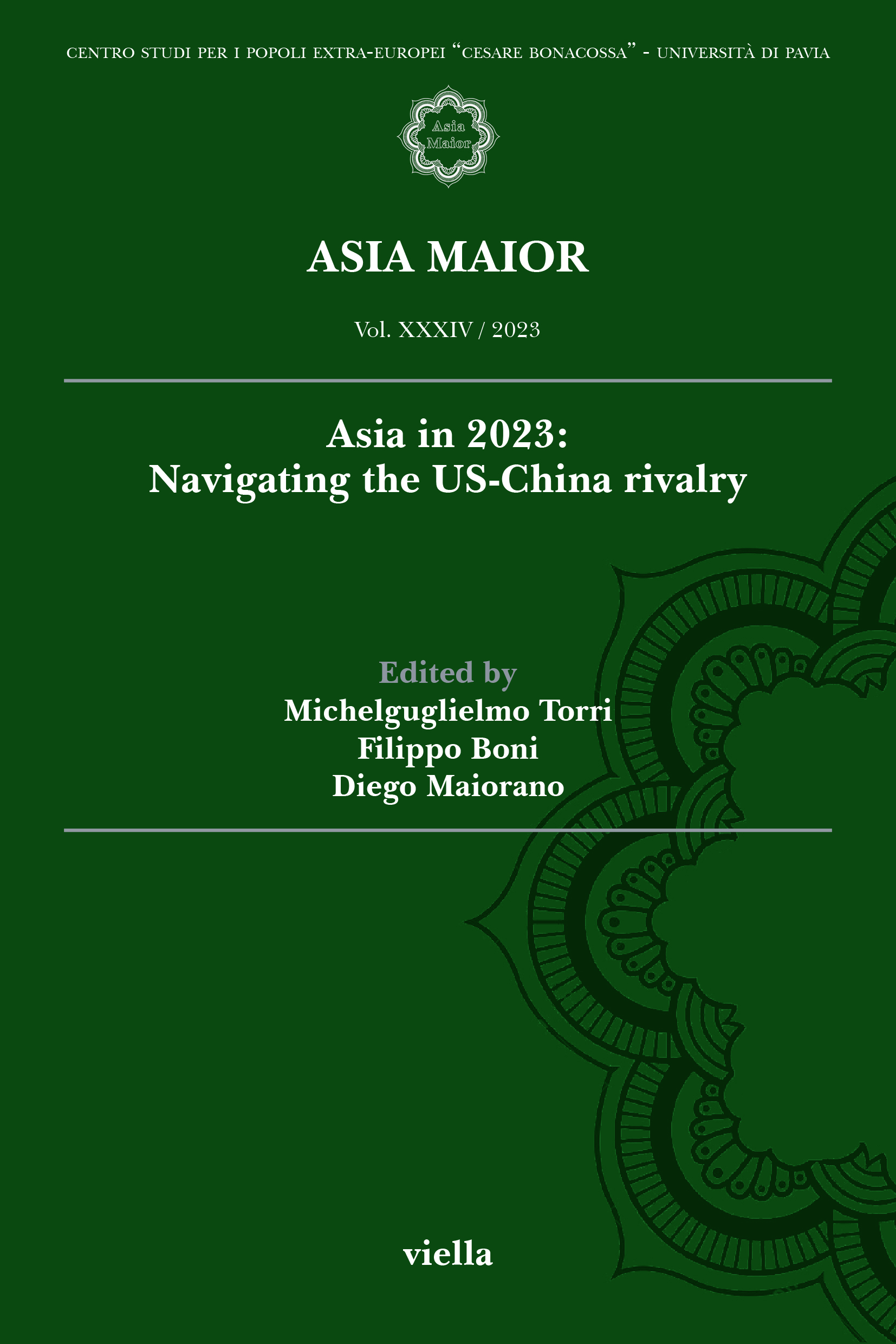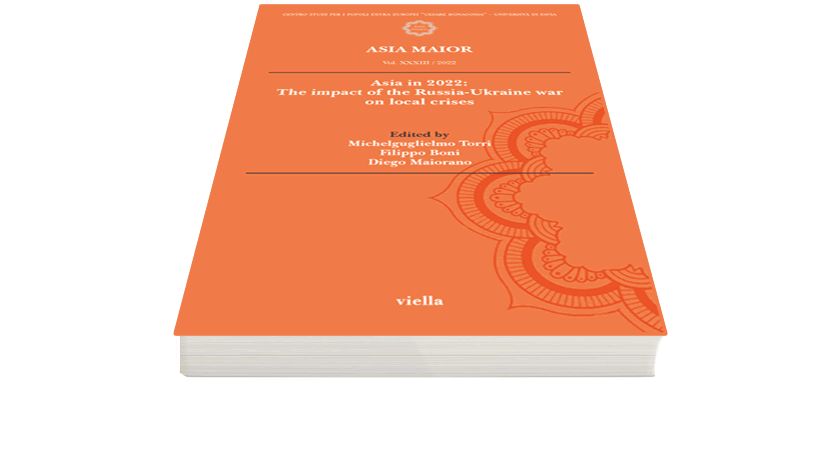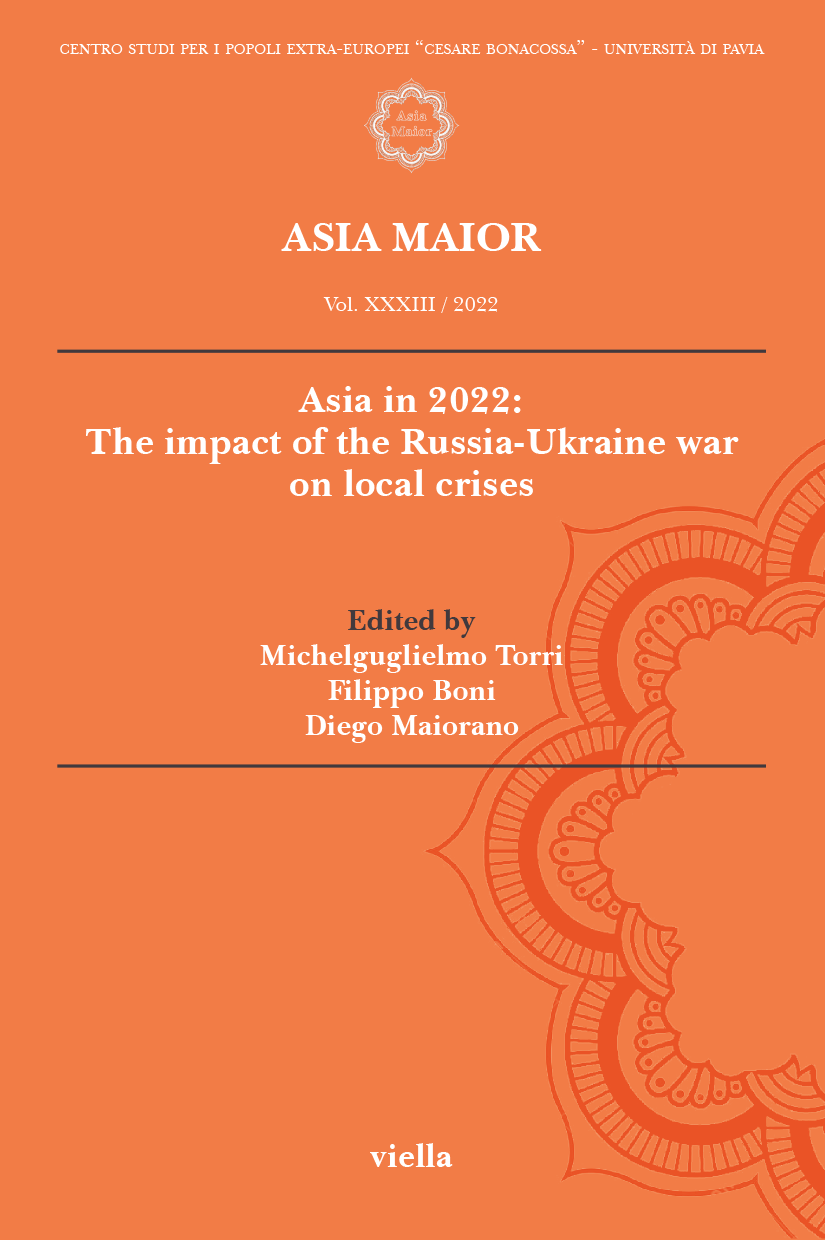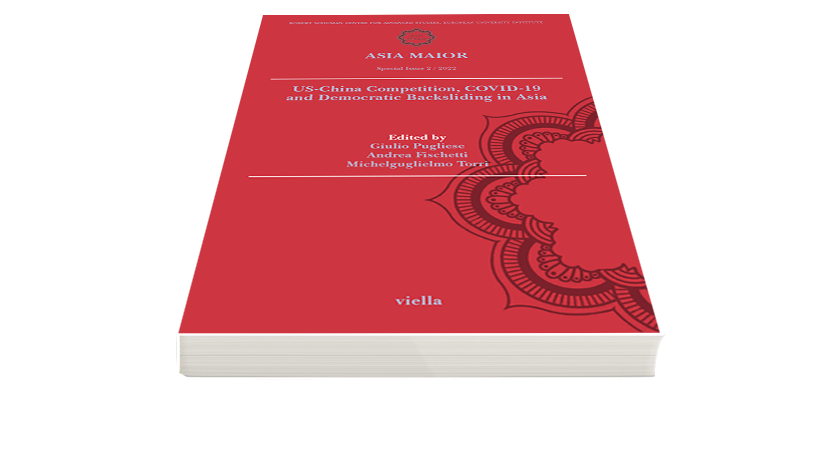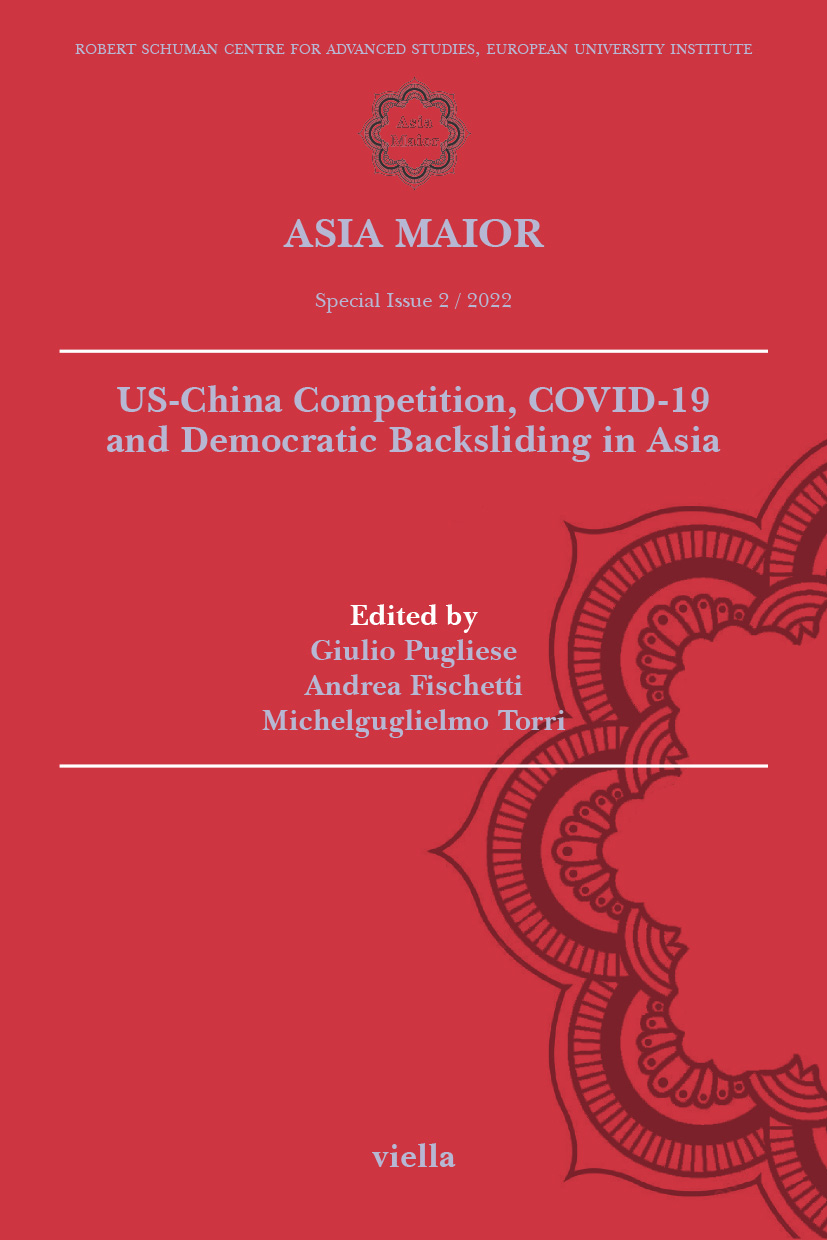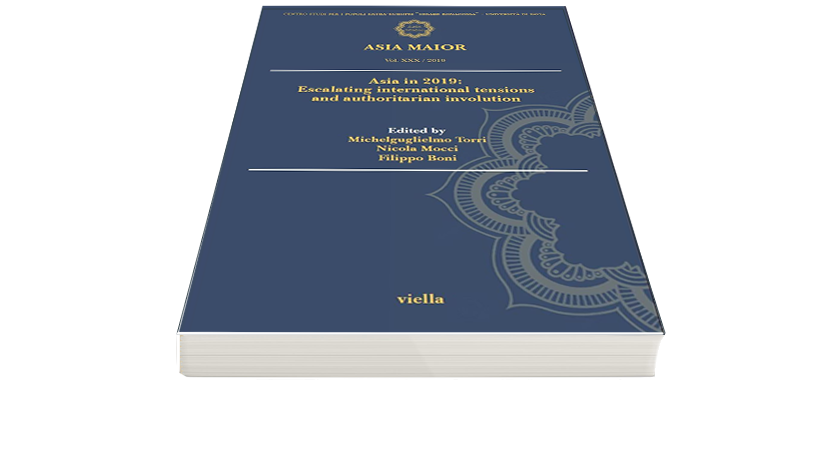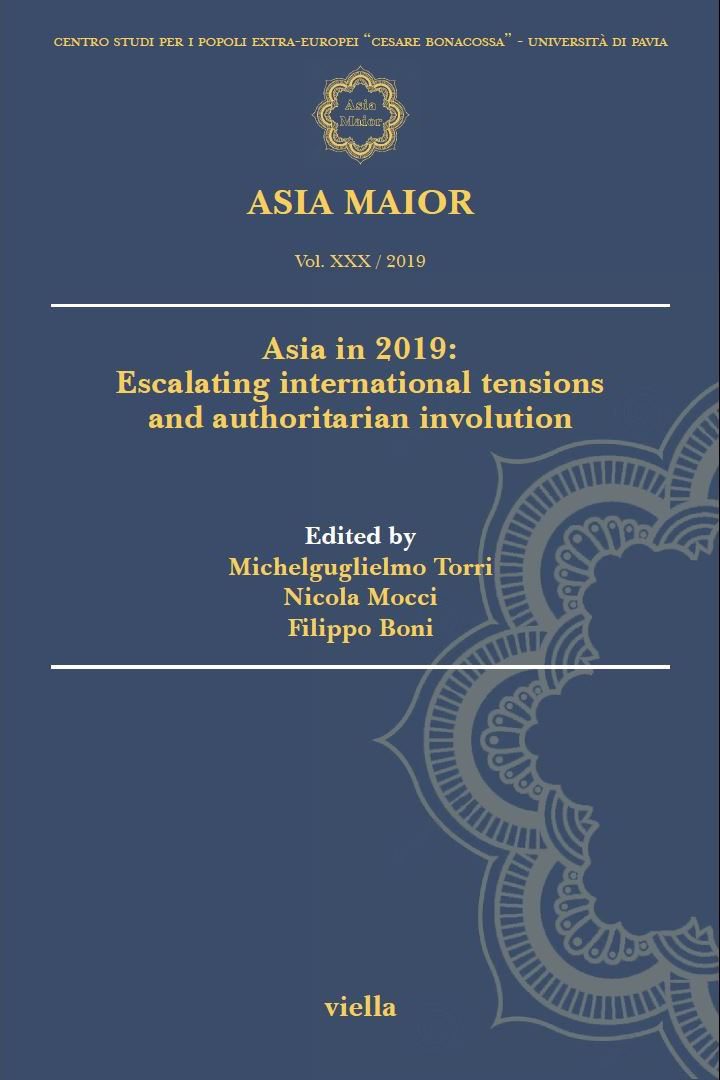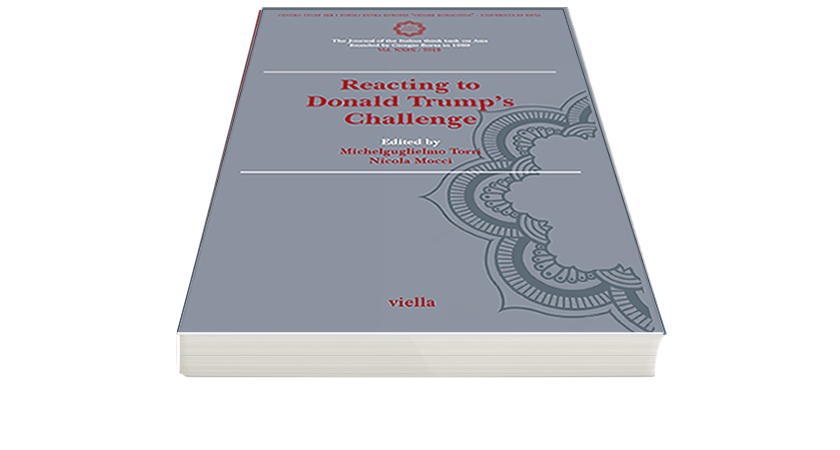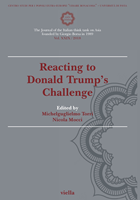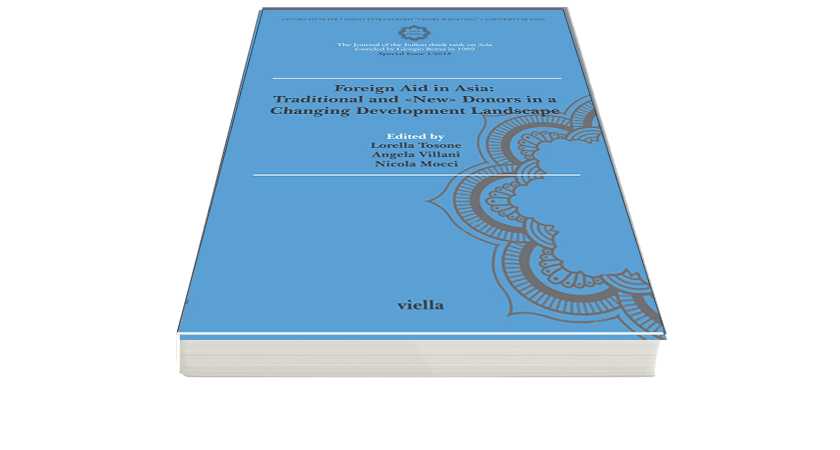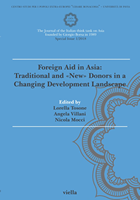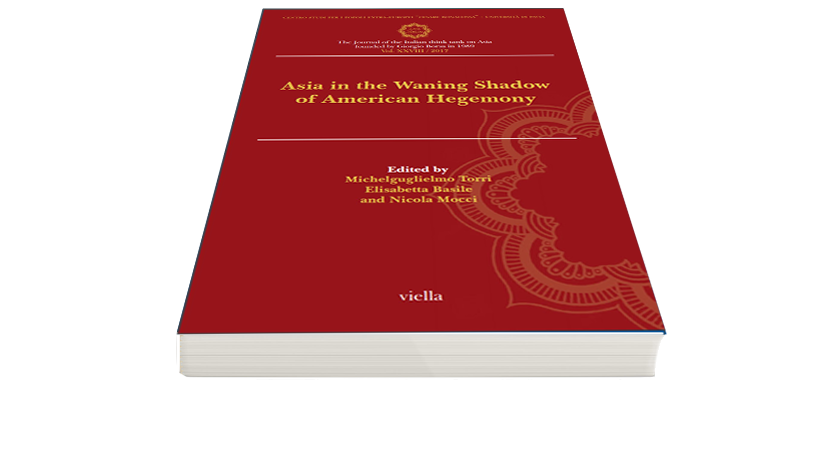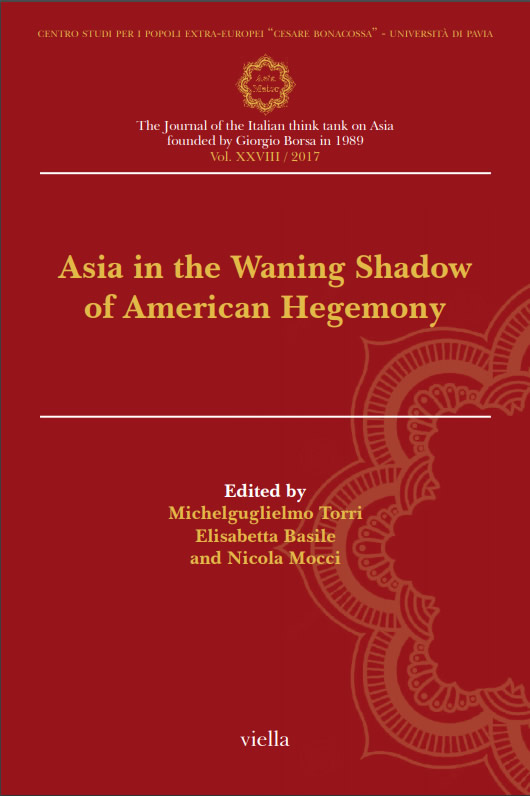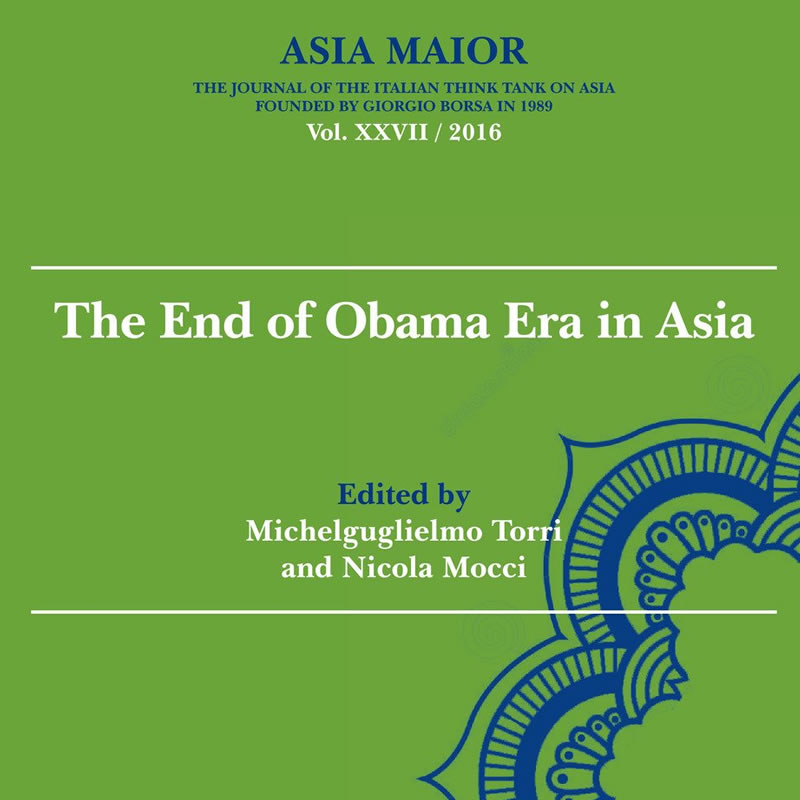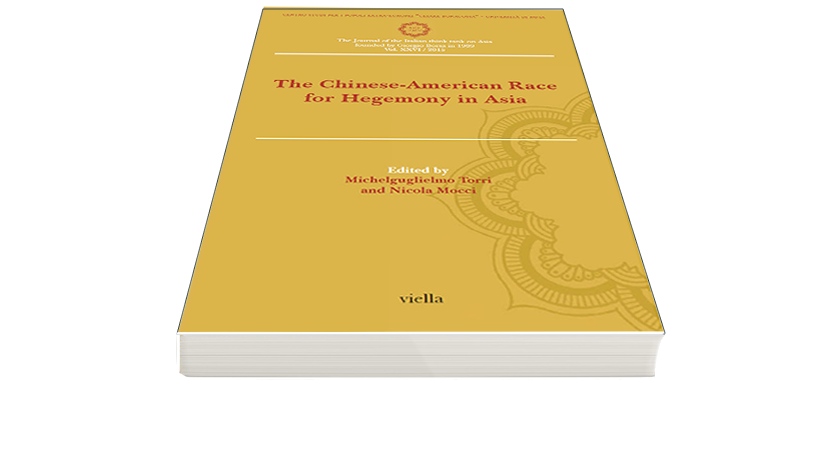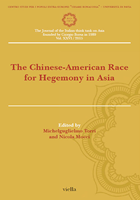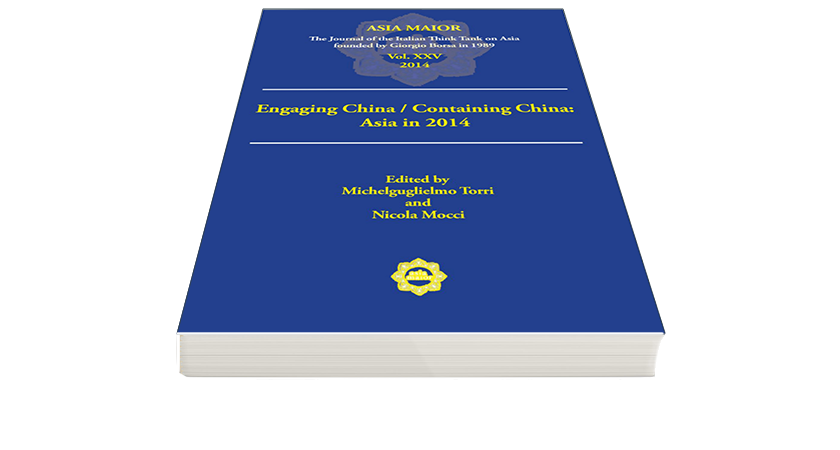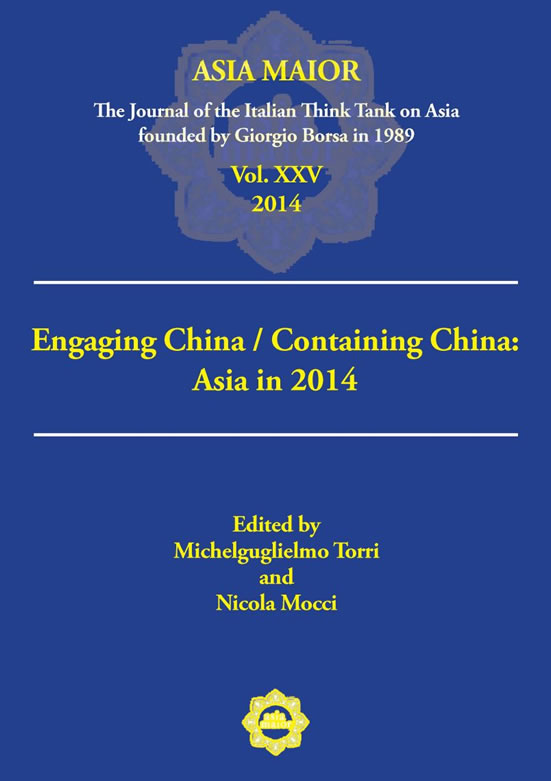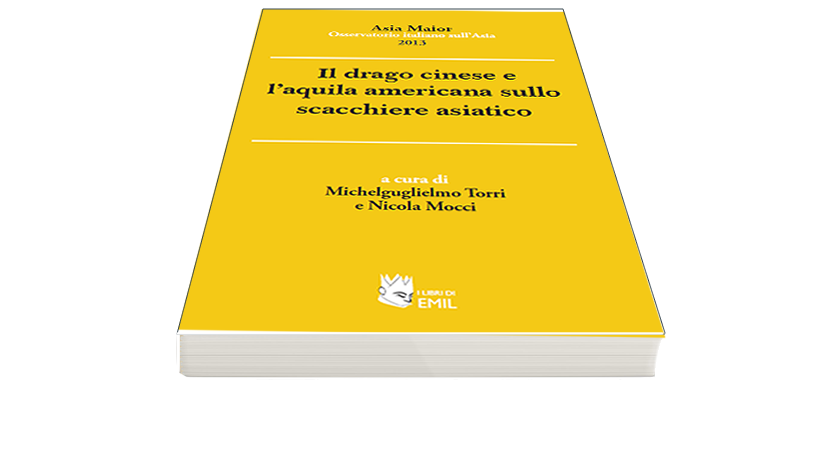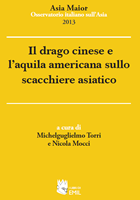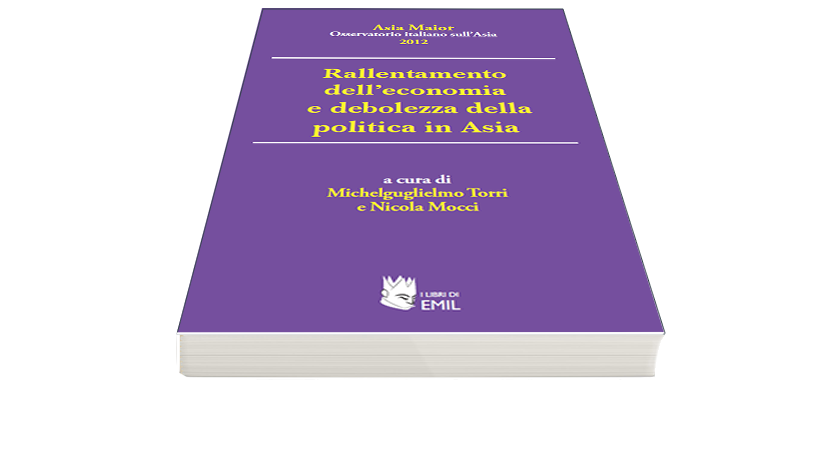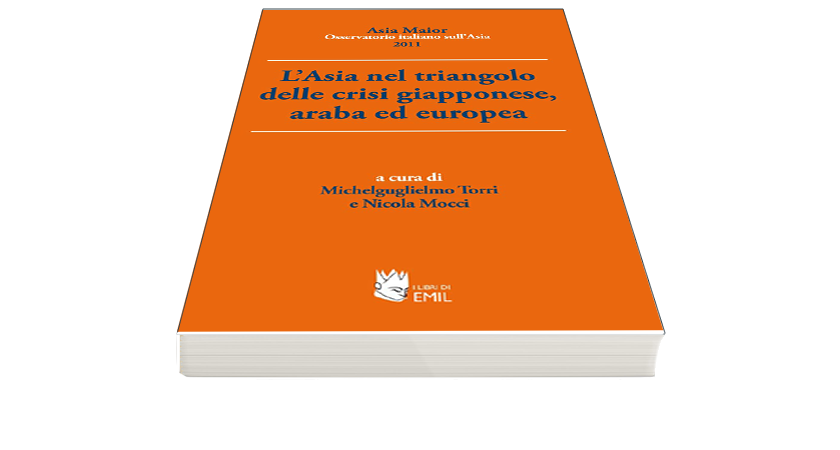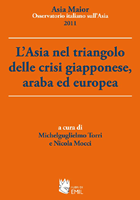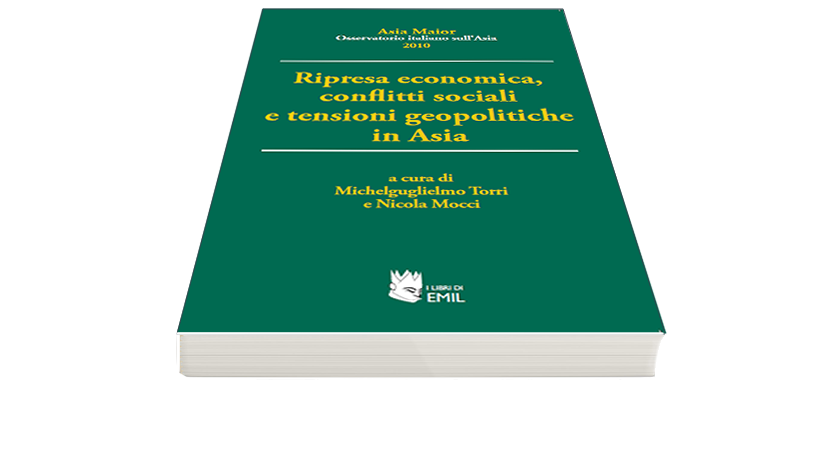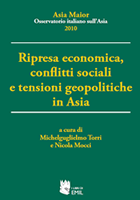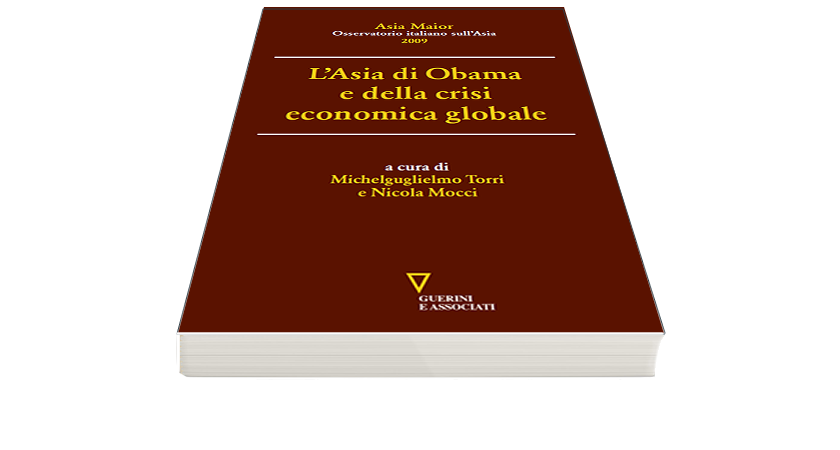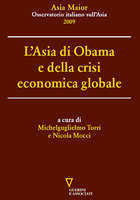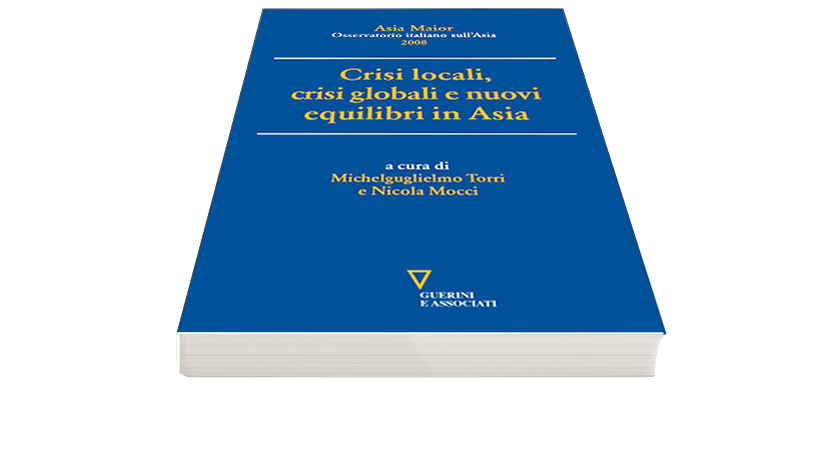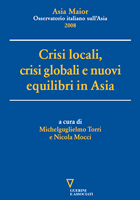China and India: Cooperation and rivalry in the global landscape and within the BRICS
The paper focuses on the economic roles and geopolitical positioning of China and India on the international stage. It analyses the relationship between these two Asian giants by examining their often-controversial interactions within the BRICS coalition. The paper is divided into threasiamaior.org/…/20-AM2024-SA-ChinaIndia-1.pdfe parts. The first part explores the sectors in which cooperation occurs at different levels, alongside the areas where competition is most intense. The second part examines the relationship between China and India within the BRICS coalition, evaluating the impact of the expansion to selected Global South countries initiated at the 2023 Johannesburg summit. The third part analyses the positions and roles of China and India within the UN system and international financial institutions. As the two most populous countries in the world, China and India wield significant influence that cannot be overlooked in international organizations. The concluding section assesses whether the intensifying competition between the two Asian giants on the global stage outweighs their limited cooperation within BRICS.
Keywords – China-India relationship; China-India Conflict and Cooperation; BRICS coalition; BRICS Plus; UN system; international financial institutions.
1. Introduction
This paper explores the relationship between China and India to assess whether cooperation or competition prevails in their interaction. The analysis focuses on economic roles and geopolitical positioning of the two Asian giants on the international stage.
A convenient framework for observing these relations is the BRICS coalition, an alliance where the specific characteristics and individual interests of the two countries must interact with the coalition’s shared goals and strategies.1 The BRICS coalition was established as a platform for cooperation among member states and draws strength from the Bandung spirit.2 The BRICS coalition fosters strong partnerships through regular meetings and holds an annual summit, culminating in a document that outlines future goals and strategies. Over time, the number of meetings between ministers has increased, broadening the areas of cooperation. Competition also arose within the coalition, particularly in terms of individual members’ relationships with external partners in Africa, Asia, and South America. So, BRICS serves both as a venue for cooperation – addressing urgent issues such as climate change – and for competition, especially concerning leadership within the coalition and global geopolitical alignment.
My argument is that, despite the significant differences between China and India and owing to their ever-closer economic ties, the two countries depend on one another to counter Western hegemony internationally and within the globalized economy.
The paper is organized in three parts. In the first part, I look at the sectors in which forms of cooperation are manifested at different levels together with the sectors for which competition is most severe. I show that trade cooperation is modest due to India’s subordinate position to China, while several cooperation agreements bring the technological development of the two countries closer together in scientific and academic collaboration. Another important area of cooperation concerns the support to multilateral institutions and their actions. However, while it is true that scientific research unites the two countries, the industrial sectors linked to technology and innovation appear to set China and India in clear competition with significant repercussions on international markets. A sensitive issue in which signs of competition emerge is geopolitical positioning. China is clearly focused on supporting developing countries through economic cooperation, characterized by significant investments and respect for sovereignty. By contrast, while continuing its international cooperation efforts, especially in Africa, India is more concerned with maintaining close relations with the West – particularly with the United States.
The second part of the paper examines the relations between China and India within the BRICS coalition. Following the expansion to selected Global South countries initiated at the 2023 Johannesburg summit, the coalition has drawn increasing scrutiny from the West. This is largely due to the coalition’s growing economic weight – now surpassing that of the G7 – and its potential challenge to the existing world order established after World War II. Even within BRICS, moments of conflict coexist with shared interests, creating significant opportunities for China-India cooperation. These primarily involve the development of new technologies for information management and the digitalization of economy and finance. Additionally, collaboration is expanding in renewable energy, emissions reduction, and climate change mitigation. Despite strong efforts to foster cooperation, underlying competition for leadership remains a major challenge to strengthening BRICS’ global influence [Cochrane & Zaidan 2024; Mooradian 2024].
The third part analyses the position and role of China and India within the UN system and international financial institutions. As the two countries with the largest populations in the world, China and India hold significant influence that cannot be overlooked in international organizations. Moreover, as emerging powers, they represent the needs and aspirations of the largest group of developing and emerging nations within these organizations. Within the UN, China is already recognized as a prominent member through its permanent seat on the Security Council, while India is only occasionally admitted. In this context, India asserts its right to a permanent seat. Similarly, in financial institutions such as the World Bank (WB) and the International Monetary Fund (IMF), China and India operate under the rules established at the Bretton Woods Conference in 1944 by the industrialized countries of the Western world. Given the economic importance of these organizations and the growing economic weight of China and India, 70 years after their founding, the two Asian giants are calling for reform. Their efforts are supported by countries with emerging and developing economies. In this way, the BRICS coalition challenges the West to redefine the global order, although Brazil, Russia, India, China, and South Africa have different reasons to do so.
The concluding section assesses whether the intensifying competition between the two Asian giants on the global stage outweighs the limited cooperation within BRICS. Based on the most recent developments, we observe the fragile relationship of trust between the two Asian giants and the limited long-term shared objectives which signals the difficulty of maintaining unity within the coalition. However, the need to work in a common way, at least in the immediate future, explains the solidarity that China and India show on many occasions.
2. Economic interdependence and geopolitical competition
While political and military tensions over the border remained significant obstacles until the early 21st century, China and India have developed strong economic ties. These ties emerged and expanded as both countries opened to international trade from the 1980s onward. However, during the first three decades of their economic liberalization, China and India pursued markedly different paths in international relations. Their mutual recognition of the benefits of trade was formally acknowledged only at the first BRICS summit in 2009. Since then, the rapid economic growth of both nations has led to a steady increase in trade flows and a series of cooperation agreements.
2.1. Domestic and international cooperation
Trade relations between China and India have grown steadily in the most recent decade, between 2012 and 2023. India’s imports from China have more than doubled, thus bringing China to the first place among India’s importing partners (122.0 US Billion $; in 2023); India’s exports to China also grew, although they remained at relatively low level (16.2 US Billion $; in 2023). Thus, since 2024 China has become India’s main trading partner, overcoming the trade flows with the United States. By contrast, India is a marginal trading partner for China, although it represents a significant outlet/ market for products such as electronics, machinery, chemicals, and active pharmaceutical ingredients.
Despite Prime Minister Modi’s Make in India initiative, which aims to reduce dependence on Chinese imports, India continues to rely heavily on China for manufacturing inputs, as evidenced by the high and growing levels of material goods imports.3
|
Tab. 1: China-India Bilateral Trade, 2012-2023 (US$, Billion) |
|
|
|
Source: United Nations COMTRADE: comtradeplus.un.org |
Beyond trade, China and India engage in extensive multilateral and regional cooperation [Bondre 2021, 8 April; Tellis & Mirski 2013]. On the global stage, both countries support each other within United Nations initiatives on climate change, technology transfer, and debt relief for developing nations. They also advocate for financial reforms in institutions such as the IMF and the WB to enhance the representation of emerging economies in decision-making processes. These efforts not only strengthen bilateral ties but also align both nations with underrepresented countries.
Environmental cooperation is another significant area. While both nations face criticism for high pollution levels, they argue for a phased transition to clean energy, emphasizing that industrialized countries should bear a greater responsibility due to their historically higher emissions. They jointly endorse the principle of Common but Differentiated Responsibilities and collaborate on clean energy research, ranking among the world’s leading producers of solar panels and wind energy components [Basile & Cecchi 2019].
During the COVID-19 pandemic, China and India cooperated by exchanging medical supplies and engaging in global health discussions at the World Health Assembly (the decision-making body of the World Health Organization) [Sen & Das 2024]. Despite India’s prominence as a producer of generic drugs, more than 70% of its active pharmaceutical ingredients still originate from China.4
Cultural cooperation between the two countries is facilitated through institutions such as Confucius Institutes, which promote Chinese language learning in India, and India’s initiatives to highlight its Buddhist heritage. However, these exchanges often take place in an atmosphere of mutual suspicion rather than genuine partnership [Shavlay 202; Das 2022].
In recent years, collaboration in digital and financial technology (FinTech) has become more complex. Until 2020, India welcomed Chinese investments in its digital economy. However, it has since restricted access to Chinese applications deemed harmful to national security and public order [India Today, December 5, 2023].
In summary, China-India cooperation is shaped by mutual recognition of their differing needs and production capacities.
2.2. Domestic and international competition
Competition between China and India is often more pronounced than their cooperation, spanning territorial disputes and global geopolitical positioning.
A key point of contention is their long-standing border dispute. The 3,440-km-long border, which remains undefined, follows the Line of Actual Control – unilaterally established by China in 1959 and confirmed after the 1962 war. This has led to multiple localized clashes over the years. However, at the 2024 BRICS summit in Kazan (Russia) China and India reached an agreement on patrolling arrangements along their disputed border, which may ease tensions between the two nuclear-armed neighbours [Reed & White 2024, 21 October].
Another area of rivalry is control over the Indian Ocean Region (IOR). China has pursued its String of Pearls strategy for decades, expanding its presence through infrastructure projects linked to the Belt and Road Initiative (BRI).56 In response, India leverages the Quadrilateral Security Dialogue (QUAD) with the U.S., Japan, and Australia to counter China’s regional influence. Additionally, India has strengthened trade and labour agreements with Taiwan, a move China perceives as a challenge to its territorial integrity. However, given the limited economic scope of these agreements, further escalation appears unlikely.
Technological and space-related competition is also intensifying. Both nations are advancing in information technology, following divergent yet ambitious strategies. China leads in technological investments, including space programs under the BRI, while India seeks to counterbalance China’s dominance by strengthening partnerships with countries wary of dependence on Chinese technology. Since 2023, India has launched several satellites, including collaborations with NASA [Bhattacharjee 2025, 16 January]. Meanwhile, China continues expanding its space program, including human spaceflight and satellite networks, while indirectly competing through projects such as the India-Middle East-Europe Economic Corridor, which is attracting growing global interest.7
Ultimately, China-India relations remain defined by pragmatism. China maintains economic and commercial dominance, while India seeks to curb China’s influence and position itself as a strategic partner to Western nations, which are gradually losing ground in Southeast Asia [Zha, 2023.
3. Global leadership and partnership with emerging countries
The story of the birth and expansion of the BRICS coalition is now widely known [Basile and Cecchi 2018, 2019, 2023], making even a brief introduction unnecessary – especially considering the 2023 summit and the recent developments in 2024. However, it is useful to highlight a few key features of this coalition and review the major milestones in its evolution.
The first notable aspect concerns the composition of BRICS and the characteristics of its member countries. When the BRIC group (Brazil, Russia, India, and China) was established in 2009, each founding country held significant economic and political weight individually. However, the potential to form a cohesive economic and political alliance capable of addressing the 2008 global financial crisis was not immediately evident. At that pivotal moment in international relations, major financial institutions largely ignored the crisis’s impact on developing and emerging economies.
The Yekaterinburg Summit (Russia) in 2009, attended by the leaders of Brazil (Luiz Inácio Lula da Silva), Russia (Dmitry Medvedev), India (Manmohan Singh), and China (Hu Jintao), was held in a spirit of demanding not only greater attention but also shared support for countries that had been largely excluded from negotiations on international financial relations. The summit concluded with the Joint Statement of the BRIC Countries’ Leaders, in which the coalition expressed its aspiration to play a more prominent role within the G20. In this statement, the BRIC leaders positioned themselves as advocates for greater representation of emerging and developing economies in international financial institutions. They also emphasized the need for a stable, predictable, and diversified international monetary system.
Within just five years, significant changes occurred with the rise of new political leaders who would shape the future trajectory of the coalition. By the 2014 summit in Fortaleza (Brazil), the key figures were Vladimir Putin for Russia, Narendra Modi for India, and Xi Jinping for China. These leadership changes had a profound impact, solidifying BRICS as a coalition increasingly focused on expanding its global economic and political influence.8 The Fortaleza Summit marked the beginning of the second cycle of BRICS summits, with participants committing to the theme Inclusive Growth: Sustainable Solutions. Over the following decade, the coalition’s ambitions to play a more dominant role on the international stage grew significantly.
|
Tab. 2a: BRICS, BRICS+ and G7 Population in 2022 |
|||
|
|
Population |
Population |
Population |
|
|
million |
Percentage relative to total BRICS members |
Percentage relative to World |
|
China |
1,410.3 |
43.8 |
17.6 |
|
India |
1,392.3 |
43.2 |
17.3 |
|
China and India |
2,802.6 |
87.0 |
34.9 |
|
BRICS* |
3,223.2 |
89.7 |
40.2 |
|
New members BRICS 2024* |
368.8 |
10.3 |
4.6 |
|
BRICS+ 2024 |
3,592.0 |
111.4 |
44.8 |
|
G7 |
775.0 |
24.0 |
9.7 |
|
World |
8,025.0 |
|
|
|
Source: data.worldbank.org |
|||
A major turning point came in 2023 at the Johannesburg Summit (South Africa), when BRICS expanded to include 10 member states. This enlargement drew intense media attention due to its strategic significance. Until 2023, the coalition’s regional composition seemed designed to include representatives from continents historically excluded from the development of contemporary capitalism. However, the admission of Saudi Arabia, the United Arab Emirates, Egypt, Ethiopia, and Iran marked a significant shift. It moved the coalition’s centre of gravity further toward Asia and underscored the increasing importance of oil- and energy-producing nations. More than ever before, this expansion required closer global attention. Furthermore, the enlargement reflects an ongoing strategic approach – not only to amplify the voices of emerging and developing nations in international fora but also to challenge the leadership of established international organizations, particularly within the United Nations.
|
Tab. 2b: BRICS, BRICS+ and G7 GDP in 2022 |
|||
|
|
GDP |
GDP |
GDP |
|
|
PPP constant 2017 international US $ |
Percentage relative to total BRICS members |
Percentage relative to World |
|
China |
25,684,415 |
58.6 |
18.5 |
|
India |
10,078,991 |
23.0 |
7.2 |
|
BRICS* |
43,847,886 |
88.6 |
31.5 |
|
New members BRICS 2024* |
5,616,017 |
11.4 |
4.0 |
|
BRICS+ 2024 |
49,463,903 |
112.8 |
35.6 |
|
G7 |
42,132,464 |
96.1 |
30.3 |
|
World |
139,033,278 |
|
|
|
*Percentage referred to BRICS+ |
|||
|
Source: data.worldbank.org |
|||
BRICS+ strategy evokes the spirit of the Bandung Conference. Key similarities include the inherent challenge to the Western-dominated world order and the explicit goal of establishing alternatives to Western institutions such as the IMF, WB, and G7. The BRICS+ coalition aims to foster a multipolar order, emphasizing cooperation among developing countries and reducing their economic dependence on the West. However, there are also significant differences. While the Bandung Conference was rooted in a strong anti-colonial and anti-imperialist ideology, BRICS+ takes a more pragmatic approach. Some members, such as India, maintain cooperative ties with the West, while others, like Russia and China, actively challenge it. Moreover, in 1955, China was still a developing country seeking alliances within the Global South, whereas today it is an economic powerhouse that largely drives the BRICS+ agenda – creating a potential imbalance within the coalition. Another key distinction is that while the Bandung Conference primarily focused on developing nations in Asia and Africa, BRICS+ includes Middle Eastern and South American countries that play crucial roles in global economic and political affairs [Adem and Thomas 2017].
The significance of the BRICS+ coalition becomes clear when comparing its global economic and political weight to that of the G7 (Tables 2a and 2b).
China and India together account for a significantly larger share of both the global population and GDP compared to the G7. While the G7 represents 30% of global GDP but less than 10% of the world’s population, the expanded BRICS alliance in 2024 includes 45% of the global population and accounts for more than 36% of global GDP. This disparity underscores how the representation of countries in international organizations, as established under the Bretton Woods system, no longer reflects contemporary demographic and economic realities.
3.1. Convergent and divergent interests of China and India in the BRICS coalition
A shared priority among BRICS members is countering US-led Western dominance in international relations. Both China and India support a new multipolar world order, advocating for reduced Western control over institutions such as the UN Security Council, the IMF, and the WB. A key motivation for reforming the Bretton Woods financial system is the perceived excessive influence of Western nations in the IMF’s governance, particularly its outdated quota system, which does not adequately reflect the rising economic power of emerging markets. BRICS members argue that they should receive a larger share of Special Drawing Rights (SDRs) to align with their growing economic weight [Arnold 2024; Tran 2024, 28 March].9
A major initiative within BRICS is the process of de-dollarization, aimed at reducing dependence on the US dollar for international transactions. Russia and its allies have accelerated this shift in response to Western sanctions following the invasion of Ukraine. The de-dollarization process, once a long-term goal, is now being actively pursued as an alternative to the US-dominated financial system and the BRICS are embarking on this process making intra-BRICS international payments with their own currencies [Arnold 2024; Greene 2023].10
The issue of financial transactions is also central to BRICS cooperation. The BRICS Cross-Border Payment System is being developed as an alternative to SWIFT, the Western-dominated financial messaging system.11 This initiative has gained momentum following the sanctions on Russia, which have encouraged BRICS countries to create mechanisms that bypass external financial controls. Institutions such as the Contingent Reserve Arrangement (CRA) and the New Development Bank (NDB) were established before the Ukraine crisis but have now become critical tools for circumventing Western financial restrictions. The Kazan Summit (2024) emphasized the importance of expanding these financial alternatives, with new BRICS+ members playing an active role in their implementation [Arnold 2024; Sithole and Hlongwane 2023].
Within the BRICS coalition, China plays a dominant role, positioning itself as the leading power of the Global South and a counterweight to US hegemony. However, this dynamic creates tensions with India, which resists subordination to Chinese leadership, as it has long aspired to be recognized as a global leader itself. On the one hand, China often presents itself as a champion of multipolarity rather than outright dominance, emphasizing “win-win cooperation” and “peaceful development.” While it may not openly declare ambitions for global leadership in the way some Western powers have, its actions strongly indicate a drive to shape the international order in ways that align with its interests. On the other hand, India asserts a leading role both globally and in Indo-Pacific region. The aspiration for recognition of its leadership was already evident in the actions of previous leaders but it has become particularly significant under Modi. Yet, the roles India’s president has secured on the international stage appear more limited compared to his predecessors [Kesgin & Wehner 2021; Palladio 2025, 17 February; Upadhyay 2022, 12 July; Vinodan & Kurian 2024].
While recent geopolitical crises have shifted global attention away from economic and environmental issues, BRICS remains engaged in addressing climate change. Both China and India have been active participants in international climate agreements, reaffirming their commitment to the principles of the UN Framework Convention on Climate Change, the Kyoto Protocol, and the Paris Agreement [Basile and Cecchi 2018; Basile and Cecchi 2019; Prys-Hansen 2022].
Ultimately, while China and India share a commitment to reshaping the global order, their conflicting geopolitical interests and economic strategies introduce challenges to achieving deeper integration within the coalition. As the above considerations suggest, within the BRICS coalition, China and India are stakeholders of economic and political interests that are partly convergent and partly divergent. Relying on the Kazan Final Declaration (2024), it is possible to summarize the areas of convergence and divergence between the two Asian giants, offering insights into the evolving dynamics of political relations within BRICS.
Areas of convergence:
- Commitment to multilateralism and a multipolar world: both China and India seek a more representative and equitable international order. However, while China aims to diminish US influence, India primarily seeks a permanent seat on the UN Security Council.
- Economic cooperation and de-dollarization: both countries support initiatives like the BRICS Cross-Border Payment System to facilitate trade in local currencies and reduce reliance on Western financial institutions.
- BRICS Expansion: both nations recognize the strategic importance of expanding BRICS membership, though their approaches differ.
Areas of divergence:
- Geopolitical tensions: despite diplomatic efforts to ease border disputes, unresolved territorial conflicts continue to create friction between China and India, potentially affecting BRICS cohesion.
- Strategic priorities in BRICS: China advocates for rapid expansion to bolster its vision of a new world order, while India favours a more measured approach. Additionally, India opposes China’s BRI, viewing it as a violation of its sovereignty.
- Developmental differences: China’s economic dominance within BRICS creates disparities in policy direction, with India seeking a more balanced and inclusive approach.
4. The international world order
The UN system and the financial institutions established at Bretton Woods cannot ignore the growing influence of China and India. Their increasing economic power, strategic ambitions, and shared vision of a multipolar world order underscore their significance. While their objectives sometimes align – such as advocating for greater representation of developing countries – their methods and aspirations often diverge due to geopolitical competition. The UN serves as a crucial platform for both nations to assert their global influence, particularly within the UN Security Council, while the Bretton Woods financial institutions regulate economic transactions in the global economy.
4.1. China and India in the UN System
China has been a permanent member of the UN Security Council since 1971, when it replaced the Republic of China (Taiwan). As one of the five permanent members, alongside France, the United Kingdom, Russia, and the United States, China exercises veto power. It is also one of the largest contributors to UN peacekeeping operations, particularly in Africa, strongly supporting development and humanitarian aid initiatives. China consistently opposes US influence in setting the agenda of both the Security Council and the General Assembly [Batman et al. 2024].
India, a non-permanent member of the UN Security Council for 16 non-consecutive years, has actively sought a permanent seat. Alongside Japan, Germany, and Brazil, India argues that its economic strength, population size, and contributions to peacekeeping missions justify its inclusion. Within the General Assembly, India promotes initiatives focused on climate change, counterterrorism, and sustainable development.
While China and India are both influential within the UN system, their engagement is marked by both competition and cooperation. Their rivalry is evident in three key areas: Security Council membership, voting patterns, and influence within UN institutions. China’s veto power grants significant leverage in global security decisions, while India continues to push for permanent membership. China has consistently opposed India’s bid, making this a major point of contention. Moreover, China has frequently blocked India’s initiatives, particularly those related to Pakistan, while India has resisted Chinese proposals that undermine its own strategic interests [Gowan 2024]. Additionally, China wields substantial influence over UN agencies, such as the Food and Agriculture Organization, whereas India, though influential, does not command the same level of institutional control.
Despite these tensions, both nations share common interests in reforming global governance and advocating for the Global South. They support multilateralism, South-South cooperation, and Sustainable Development Goals. Both contribute to UN peacekeeping missions and collaborate on climate negotiations under the UN Framework Convention on Climate Change. As already said, they emphasize the principle of Common but Differentiated Responsibilities and call for greater financial and technological support from developed nations to meet Paris Agreement targets [Qin 2024]. While security and geopolitical conflicts persist, their mutual interest in restructuring global governance ensures that cooperation remains a fundamental aspect of their UN engagement.
4.2. India and China in the World Bank and the International Monetary Fund
The WB provides loans and development finance to low- and middle-income countries, while the IMF supports financial stability. China and India, as major emerging economies, play critical roles as recipients, lenders, and decision-makers within these institutions. However, decision-making processes in these organizations are still influenced by post-World War II economic and political structures that favour Western dominance.
China has voting rights in the IMF and has pushed for broader recognition of emerging economies’ economic weight. However, its influence remains constrained by existing governance mechanisms that allocate voting power based on a formula established in 1944 (with subsequent adjustments), considering GDP, economic openness, transaction variability, and reserve contributions. Despite these limitations, China continues to advocate for greater representation of developing countries and leverages the growing influence of its financial sector to bolster its demands.
China has also become a major global lender, providing loans through the Asian Infrastructure Investment Bank AIIB and the BRI. Along with the NDB, these institutions serve as alternatives to the WB and IMF, positioning China as a key competitor in global finance.
India plays a dual role in the international financial system. It is a significant recipient of WB loans, particularly for infrastructure, health, education, and poverty reduction projects, while also advocating for increased representation of emerging economies in global financial decision-making. Through its participation in the NDB, India supports developing countries in reducing reliance on Western-dominated financial institutions and promotes South-South cooperation.
Tensions between China and India within these institutions manifest on three levels. First, in the IMF, both nations advocate for increased voting power for emerging economies. However, China also engages in bilateral agreements that sometimes limit India’s influence within the organization [Asmus-Bluhm et al. 2024]. Second, through BRICS, China and India have jointly established the NDB and participate in the AIIB. While these institutions challenge Western dominance, China holds a stronger leadership position, with India playing a secondary role [Humphrey & Chen 2021; Zhu 2024]. Third, China’s financing of Belt and Road Initiative (BRI) projects has sparked Indian opposition, as India views these loans as creating debt dependencies that could compromise the sovereignty of recipient nations [Papa & Petry 2024; Patrick 2024].
Despite these tensions, China and India share key interests in financial governance reforms. Both advocate for restructuring the IMF and WB to grant greater influence to developing nations. They also collaborate within the G20 to challenge Western financial dominance and push for de-dollarization by increasing international transactions in local currencies. Furthermore, both nations support debt relief for developing countries and climate finance initiatives [Maglia et al. 2024].
In conclusion, while China and India compete for leadership and influence within global financial institutions, they also cooperate in reducing dependency on the US dollar and strengthening economic alliances with the Global South. Their roles within the UN, WB, and IMF reflect a complex interplay of competition and collaboration, driven by their evolving economic priorities and geopolitical aspirations.
5. The BRICS coalition and the challenge to Western hegemony
As discussed above, within the BRICS coalition, China and India hold economic and political interests that are partly convergent and partly divergent.
Moreover, BRICS – particularly with its expansion through BRICS+ – actively challenges the Western hegemony that has dominated global politics since the end of World War II. It does so through mechanisms that differ significantly from those underpinning the existing world order. While China remains central to this challenge, and despite the growing divergences among BRICS members with each enlargement, the coalition seeks to build broad consensus by reinforcing multilateralism.
BRICS’s positioning in the international arena – particularly in its engagements with the Global South – is characterized by the following principles of international cooperation:
- Respect for national autonomy and sovereignty
- Trade policies that do not impose external conditions
- Economic cooperation based on equity
- Financing of infrastructure investments
- Establishing itself as a new leader in global institutions
At first glance, BRICS presents itself as a unified bloc committed to non-alignment. This stance is evident in the principles that members are expected to uphold – particularly the emphasis on sovereignty and autonomy – that contrast sharply with the governance frameworks established under the Bretton Woods system.
However, as discussed in previous sections, the alignment between China and India is largely superficial. Their ability to maintain cooperation depends on systematically managing internal and external competition without allowing tensions to escalate. While the BRICS coalition frequently emphasizes unity, this unity exists only to the extent that it does not challenge the leadership ambitions of either China or India in specific domains.
Alongside the reasons for cooperation, competition also plays a significant role. As examined earlier, China and India systematically avoid direct confrontation on the international stage. China positions itself as a dominant supplier of goods and services, while India benefits from Chinese technological leadership by engaging only in trade sectors where it does not compete directly. Even in long-standing territorial disputes – such as the Himalayan border issue – the two countries have, in recent years, prioritized de-escalation over confrontation. Rather than resolving these disputes, they have chosen to minimize tensions and maintain a façade of diplomatic stability.
In contrast, economic and strategic initiatives such as China’s BRI and the India’s IMEEC remain distinct and competitive, despite involving different participants and operating on vastly different scales.
Another shared interest between China and India is their role in international financial institutions. While China is a full voting member of the IMF, India remains a second-tier participant. However, both nations advocate for reforms that would reduce the disproportionate influence of founding Western economies and increase the representation of emerging markets. Additionally, China and India have pursued alternative financial mechanisms, including the CRA and the NDB. However, these institutions have yet to pose a significant challenge to the Bretton Woods system, primarily because the governance structures of Western-led financial institutions remain adaptable to global financial shifts – though at a slower pace than many emerging economies desire.
The much-discussed de-dollarization process, often framed as a primary objective for China and an initiative supported by India, appears to be progressing slowly. Rather than representing a concrete strategy, it currently functions more as a geopolitical signal than as an imminent transformation of global financial transactions.
As we have seen, the areas of convergence between China and India outweigh their differences. However, while their divergences are limited, they remain significant enough to shape BRICS dynamics. One key finding in this paper is that within the UN system, China – due to its economic scale, geopolitical influence, and leadership in global affairs – emerges as the de facto leader of BRICS, while India, despite its aspirations, plays a more secondary role within the coalition.
Given these dynamics, several critical questions remain regarding BRICS’s future in global economic development:
Will resource competition lead to economic or geopolitical conflicts among BRICS members?
Can China sustain its role as the “wealthier relative” in the coalition?
Will BRICS’s approach to global governance gain precedence over the G7 framework?
Can reforms in international institutions accommodate a new multipolar world order?
Despite their geopolitical rivalry, China and India share strategic and economic interests within BRICS and in other global organizations. Both nations seek to counterbalance Western dominance, reduce dependence on the US dollar, and advocate for a greater role for emerging economies in global decision-making. However, their motivations differ: while China pursues hegemony and global leadership, India seeks strategic autonomy, balancing its foreign policy between East and West.
Within BRICS, both countries leverage their influence to defend Global South interests, push for financial institution reforms, and develop alternatives to Western-led economic structures. Yet, their bilateral relationship remains tense, with competition in global markets outweighing their cooperation within BRICS. Recent developments indicate that China-India relations are shaped by pragmatic, selective cooperation driven by mutual economic interests rather than trust or shared long-term strategic goals.
Bibliography
Acharya, Amitav, and Sen Tang, 2008, Bandung Revisited. The Legacy of the 1955 Asian-African Conference for International Order, National University Singapore: Singapore Press.
Adem, Seifudein, and Darryl C. Thomas, 2017, ‘From Bandung to BRICS’, in Routledge Handbook of Africa-Asia Relations, edited by Pedro Amakasu Raposo, David Arase, Scarlett Cornelissen, London: Routledge.
Arnold, Theryn D., 2024, ‘De-dollarization and global sovereignty: BRICS’ quest for a new financial paradigm’, Human Geography, November.
Basile, Elisabetta, and Claudio Cecchi, 2018, ‘Will the BRICS succeed in leading the way to sustainable development?’ Rivista di Studi Politici Internazionali, 85, pp. 223-234.
Basile, Elisabetta, and Claudio Cecchi, 2019, ‘The Uncertain Sustainability of BRICS Strategies for Sustainable Development’, Rivista di Studi Politici Internazionali, 86, pp. 261-280.
Basile, Elisabetta, and Claudio Cecchi, 2023, ‘Varietà di capitalismo e varietà di interessi nella coalizione BRICS’, in Marco Ricceri (ed.) BRICS. Costituzione, Evoluzione, Prospettive di un Nuovo Modello di Cooperazione Internazionale, Roma: Armando Editore.
Bharti, Mukesh Shankar, 2023, ‘China’s Belt and Road Initiatives (BRI) in South Asia and Its Policy Challenges to India in the Region’, South Asian Survey, 30(2), 154-174.
Bhattacharjee, Nivedita, 2025, 16 January, ‘India achieves milestone as fourth nation to succeed in space docking,’ Reuters.
Bondre, Kaustubh, 8 April, 2021, ‘Are India and China destined to be adversaries?’ Indian School of Public Policy.
Booz Allen, Hamilton, 2007, Energy Futures in Asia. After Action Report, Virginia: USA Office of the Secretary of Defence, April.
Cochrane, Logan, & Esmat Zaidan, 2024, ‘Shifting global dynamics: an empirical analysis of BRICS + expansion and its economic, trade, and military implications in the context of the G7,’ Cogent Social Sciences, 10:1.
Das, Supradip, 2022, 17 March, ‘Implications of Cultural Exchanges on India-China Ties and Way Forward’, Organization for Research on China and India (ORCA).
Gerda Asmus-Bluhm, Vera Z. Eichenauer, Andrea Fuchsh, Bradley Parks, 2024, ‘Does India Use Development Finance to Compete with China? A Subnational Analysis’, Journal of Conflict Resolution 0 (0).
Gowan, Richard, 2024, ‘Accommodation available: China, Western powers and the operation of structural power in the UN Security Council’, Global Policy, 15 (Suppl. 2), pp. 29-37.
Greene, Robert, 2023, The Difficult Realities of the BRICS’ De-dollarization Efforts— and the Renminbi’s Role, Washington: Carnegie Endowment for International Peace.
Humphrey, Chris, and Yunnan Chen, 2021, China in the multilateral development banks: Evolving strategies of a new power, ODI Report, London: Overseas Development Institute (ODI).
Kesgin, Barış, & Leslie E. Wehner, 2021, ‘The “I” in BRICS: leadership traits of Indian prime minister and India’s role adaptation to rising status in world politics’, Journal of International Relations and Development, 25: pp. 370–398.
Kharel, Aswasthama Bhakta, 2020, ‘Non-Aligned Movement: Challenges and Way Forward,’ Molung Educational Frontier, 10, pp. 1-12.
Levitan, Nir, Arie Reich, and Jonathan Rynhold, 2025, From Conflict to Connectivity: The India-Middle East-Europe Corridor Amidst Geopolitical Turbulence, Bar Ilan University Faculty of Law Research Paper No. 5117805.
Maglia, Cristina, Ole Jacob Sending, Morten Bøås, Cedric de Coning, Stein Sundstøl Eriksen, John Karlsrud, and Indra Øverland, 2024, Emerging powers, the G20, and reform of multilateral institutions, Oslo: Norwegian Institute of International Affairs.
Manhas, Neeraj Singh, 2020, ‘China’s Policy of ‘String of Pearls’, International Journal of Social Impact, Volume 5, Issue 3.
Marco Cipriani, Linda S. Goldberg, Gabriele La Spada, 2023, ‘Financial Sanctions, SWIFT, and the Architecture of the International Payment System’, Journal of Economic Perspectives, 37(1), pp. 31-52.
Max-Otto Batman, Sebastian Haug, Silke Weinlich, 2024, ‘From developing country to superpower? China, powershifts and the United Nations development pillar’, Global Policy, 15 (Suppl.), pp. 51-61.
Mooradian, Maximilian G., 2024, The BRICS Challenge to the G7 Established International order, Philadelphia: Foreign Policy Research Institute.
Palladio, Ana, 2025, 17 February, ‘India Has Arrived’, Project Syndicate – Politics.
Papa, Fabian, & Johannes Petry, 2024, ‘East Asia and the politics of global finance: a developmental challenge to the neoliberal consensus?’, Review of International Political Economy, 31 (1), pp. 224-252.
Patrick, Stewart, 2024, 9 October, ‘BRICS Expansion, the G20, and the Future of World Order’, Carnegie Endowment for International Peace.
Prys-Hansen, Miriam, 2022, ‘Competition and Cooperation: India and China in the Global Climate Regime’, GIGA Focus Asia, No 4.
Qin, Shuyu, 2024, ‘Sino-Indian Climate Cooperation under Global Development Initiative: History, Challenges and Opportunities’, Transactions on Social Science, Education and Humanities Research, Volume 6.
Reed, John, & Edwards White, 2024, 21 October, ‘India says deal reached with China on patrols at disputed borders’, Financial Times.
Saaida, Mohammed, 2024, ‘BRICS Plus: de-dollarization and global power shifts in new economic landscape’, BRICS Journal of Economics, 5 (1), pp. 13-33.
Sen, Rahul R., and Sanchita Basu Das, 2024, ‘Did economic cooperation encourage trade in essential medical goods? Empirical evidence from the Asia–Pacific during COVID-19’, Asian Economic Journal, 38, pp. 35–60.
Shastry, Vasuki, 2024, ‘‘Make in India’ Ten Years Later: Speed Bumps and Roadblocks’, FORBS, Sept. 24, www.forbes.com.
Shavlay, Ellina, 2021, India-China Relations: Cultural Aspect (available at SSRN: https://ssrn.com/abstract=3949510).
Singh, Satyam, Waseem Raja, Sandeep Kumar, Akriti Uppal, Neeta Rani, 2024, 30 November, ‘India-Middle East-Europe Economic Corridor: A Strategic Energy Alternative’, Energy RESEARCH LETTER, 6(4), https://doi.org/10.46557/001c.123649.
Sithole, Mixo Sweetness, and Nyiko Worship Hlongwane, 2023, ‘The role of the New Development Bank on Economic growth and Development in the BRICS states,’ MPRA Paper No. 119958.
Tellis, Ashley J., & Sean Mirski, 2013, Crux of Asia. China, India and the Emerging Global Order, Washington: Carnegies Endowment for international Peace.
Tran, Hung, 2024, 28 March, ‘Understanding the debate over IMF quota reform’, Econographics.
Tripathy, Anshuman, Sudha Madhavi Dastrala, 2023, Make in India: So Far and Going Ahead, IIM Bangalore Research Paper No. 674
Upadhyay, Shreya, 2022, 12 July, ‘BRICS, Quad, and India’s Multi-Alignment Strategy’, Stimson Center, Commentary Asia & Indo-Pacific.
Vinodan, C., & Anju Lis Kurian, 2024, ‘Strategic Autonomy and India’s Hedging Policies in the Indo-Pacific’, Journal of Asian Security and International Affairs, 11 (4), pp. 475-495.
Weber, Heloise, & Poppy Winanti, 2016, The “Banding Spirit” and solidarist Internationalism’, Australian Journal of International Affairs, 70 (4), pp. 391-406.
Zamhari, Adem, & Daba Debo, 2024, BRICS and the Quest for Economic Autonomy: De-Dollarization’s Global Ripple Effects (https://www.researchgate.net/publication/387799170_BRICS_and_the_Quest_for_Economic_Autonomy_De-Dollarization’s_Global_Ripple_Effects).
Zha, Wen, 2023, ‘Southeast Asia amid Sino-US. Competition Zha and Regional Order Transition’, The Chinese Journal of International Politics, 16, pp. 241–261.
Zhu, Jiejin, 2024, ‘Why China supports NDB membership expansion: Going multilateral amid power struggles’, Global Policy, 15 (2), pp. 443-450.
1. The BRICS coalition, comprising Brazil, Russia, India, China, and later South Africa, was formed through several key steps. The acronym BRIC was coined in 2001 by Jim O’Neill of Goldman Sachs to describe four rapidly growing economies. The foreign ministers of the BRIC countries held their first formal meeting on the sidelines of the United Nations General Assembly in September 2006 in New York. The first formal summit of the BRIC took place in 2009, in Yekaterinburg, Russia. South Africa was invited to join the group in December 2010 and its participation was formalized at the BRICS Summit in April 2011. The decision to expand the BRICS coalition, informally referred to as BRICS+, was made during the 15th BRICS Summit (2023) when the group extended invitations to join to Argentina, Egypt, Ethiopia, Iran, Saudi Arabia, and the United Arab Emirates. These nations were invited to become full members starting from January 2024. While, following the election of President Milei, Argentina reversed the decision in November 2023, in January 2025 Indonesia has joined BRICS as a full member.
2. Here the reference is to the Bandung Conference (April 1955) in which a group of Asian and African countries strongly emphasized that peace and security could be enhanced only by international cooperation. The Conference opposed to colonialism and imperialism and promoted the five principles of peaceful coexistence that influenced the future of Non-Aligned Movement: respect for sovereignty, non-aggression, non-interference, equality, and peaceful coexistence [Weber & Winanti 2016; Kharel 2020]. It is interesting to note that the BRICS coalition includes countries that at the time of the Bandung Conference were not aligned with Western countries and countries that belonged to the communist world [Adem and Thomas 2017; Acharya and Tang 2008].
3. The Indian Prime Minister started the campaign Make in India in September 2014. Make in India 2.0 was introduced in 2019 as an upgraded version of the original initiative. Since 2020, the initiative has been supported by the intervention programme called Aatma Nirbhar Bharat Abhiyan (self-reliant India mission). However, many authors believe that, overall, the campaign has substantially failed in its aims [Tripathy & Dastrala, 2023; Shastry, 2024].
4. The information, which is relative to fiscal year 2023-2024, comes from Pharmabiz.com (India’s most comprehensive pharma portal – 6 May 2024).
5. The term “String of Pearls” was first introduced in a report by the consulting firm Booz Allen Hamilton for the U.S. Department of Defence, published in 2004 and later in 2007. It describes China’s maritime activities and strategy, analysing its presence in the Indian Ocean Region (IOR) and beyond through a network of commercial and military bases and infrastructure projects along key maritime trade routes. The “pearls” refer to ports, airstrips, naval facilities, and economic zones in strategically located countries along sea lanes connecting China to the Middle East, Africa, and Europe. This initiative complements China’s Belt and Road Initiative (BRI) and aligns with its long-term objectives of securing trade routes, ensuring energy security, and expanding its regional influence [Booz Allen 2007; see also Manhas 2020].
6. The Belt and Road Initiative (BRI) is a Chinese development strategy launched in 2013 by President Xi Jinping and operational since 2015. Funded by the Silk Road Fund and the Asian Infrastructure Investment Bank (AIIB), the BRI involves numerous countries across the East and West in developing transport infrastructure to connect Asia, Europe, and Africa along five routes. The initiative consists of two major components: the Silk Road Economic Belt, which links China to Russia and the Middle East through Central Asia and connects China with Southeast and South Asia and the 21st Century Maritime Silk Road, which links China to the South Pacific and Europe via the South China Sea and the Indian Ocean. For further details, see the Belt and Road Portal (Official Website: eng.yidaiyilu.gov.cn); also see [Basile and Cecchi 2019] and [Bharti 2023]
7. India-Middle East-Europe Economic Corridor (IMEEC) is an initiative planned by the United States in the 2023 G-20 Summit strongly supported by the Indian President Modi. IMEEC is a multinational infrastructure initiative aimed at enhancing trade and connectivity between India, the Middle East, and Europe through a combination of rail and shipping networks [Levitan et al. 2025; Singh et al. 2024].
8. This is confirmed by the fact that the three leaders are still in charge of their countries in the Kazan Summit, 10 years later!
9. Special Drawing Rights (SDRs) serve multiple functions. Within the system, they determine the level of financial resources available to each member in times of need. In the management of IMF decisions, SDRs define the voting power of each country on the Board of Governors. This power is determined by a “quota”, which measures a country’s significance based on several indicators, the most important of which is GDP. The quota is reviewed every five years. For example, according to the most recent quinquennial SDR valuation review, the US dollar accounts for 43%, the euro for 29%, and the Chinese renminbi for 12%. China, with the support of emerging economies, is advocating for more frequent adjustments that reflect economic growth differentials, as well as a broader reform that grants greater influence to emerging and developing countries. See IMF webpage on Quinquennial SDR valuation review: www.imf.org/en/About/Factsheets/Sheets/2023/special-drawing-rights-sdr.
10. The BRICS coalition has supported the de-dollarization path to pursue economic sovereignty, trade efficiency, and political autonomy. However, coalition members can pursue their own paths to reduce their dependence on US dollar [Saaida 2024; Zamhari and Daba 2024].
11. The Society for Worldwide Interbank Financial Telecommunication (SWIFT) facilitates secure and standardized communication between financial institutions for international transactions. It acts as a mechanism for enforcing economic policies and sanctions, thereby influencing geopolitical strategies and alliances [Cipriani et al. 2023].
Asia Maior, XXXV / 2024
© Viella s.r.l. & Associazione Asia Maior
ISSN 2385-2526
